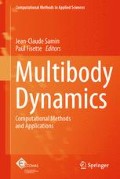Abstract
In this chapter, an enhanced methodology for interactive, accurate, fast and robust multibody simulations using Augmented Reality is presented and discussed. This methodology is based on the integration of a mechanical tracker and a dedicated impulse based solver. The use of the mechanical tracker for the interaction between the user and the simulation allows to separate the processing of the data coming from the position tracking from those coming from the image collimation processing. By this way simulation results and visualization remain separated and the precision is enhanced. The use of a dedicated sequential impulse solver allows a quick and stable simulation also for a large number of bodies and overabundant constraints. The final result of this work is a software tool able to manage real time dynamic simulations and update the augmented scene accordingly. The robustness and the reliability of the system will be checked over two test cases: a ten pendula dynamic system and of a cross-lift mechanism simulation.
Access this chapter
Tax calculation will be finalised at checkout
Purchases are for personal use only
Notes
- 1.
The ARToolkit libraries can be freely downloaded from the Internet site http://sourceforge.net/project/showfiles.php?group_id=116280.
- 2.
- 3.
The library can be freely downloaded from the Internet site http://openvrml.org/.
References
Azuma, R., Baillot, Y., et al.: Recent advances in augmented reality. IEEE Comput. Graph. Appl. 21(6), 34–47 (2001)
Gattamelata, D., Pezzuti, E., Valentini, P.P.: A CAD system in augmented reality application. In: Proc. of 20th European Modeling and Simulation Symposium, Track on Virtual Reality and Visualization, Briatico (CS), Italy (2008)
Valentini, P.P.: Augmented reality and reverse engineering tools to support acquisition, processing and interactive study of archaeological heritage. In: Virtual Reality. Nova Publ., New York (2011)
Raghavan, V., Molineros, J., Sharma, R.: Interactive evaluation of assembly sequences using augmented reality. IEEE Trans. Robot. Autom. 15(3), 435–449 (1999)
Pang, Y., Nee, A.Y.C., Ong, S.K., Yuan, M.L., Youcef-Toumi, K.: Assembly feature design in an augmented reality environment. Assem. Autom. 26(1), 34–43 (2006)
Valentini, P.P.: Interactive virtual assembling in augmented reality. Int. J. Interact. Des. Manuf. 3, 109–119 (2009)
Valentini, P.P.: Interactive cable harnessing in augmented reality. Int. J. Interact. Des. Manuf. 5(1), 45–53 (2011)
Gattamelata, D., Pezzuti, E., Valentini, P.P.: Virtual engineering in augmented reality. In: Computer Animation, pp. 57–84. Nova Publ., New York (2010)
Valentini, P.P.: Enhancing user role in augmented reality interactive simulations. In: Human Factors in Augmented Reality Environments. Springer, Berlin (2012)
Buchanan, P., Seichter, H., Billinghurst, M., Grasset, R.: Augmented reality and rigid body simulation for edutainment: the interesting mechanism—an AR puzzle to teach Newton physics. In: Proc. of the International Conference on Advances in Computer Entertainment Technology, Yokohama, Japan, pp. 17–20 (2008)
Chae, C., Ko, K.: Introduction of physics simulation in augmented reality. In: Proc. of the 2008 International Symposium on Ubiquitous Virtual Reality, ISUVR, pp. 37–40. IEEE Comput. Soc., Washington (2008)
Kaufmann, H., Meyer, B.: Simulating educational physical experiments in augmented reality. In: ACM SIGGRAPH Asia (2008)
Irawati, S., Hong, S., Kim, J., Ko, H.: 3D edutainment environment: learning physics through VR/AR experiences. In: Proc. of the International Conference on Advances in Computer Entertainment Technology, pp. 21–24 (2008)
Mac Namee, B., Beaney, D., Dong, Q.: Motion in augmented reality games: an engine for creating plausible physical interactions in augmented reality games. Int. J. Comput. Games Technol. 2010, 979235 (2010)
Valentini, P.P., Pezzuti, E.: Interactive multibody simulation in augmented reality. J. Theor. Appl. Mech. 48(3), 733–750 (2010)
Azuma, R.T.: Tracking requirements for augmented reality. Commun. ACM 36(7), 50–51 (1993)
Mirtich, B.V.: Impulse-based dynamic simulation of rigid body systems. Ph.D. thesis, University of California, Berkeley (1996)
Schmitt, A., Bender, J.: Impulse-based dynamic simulation of multibody systems: numerical comparison with standard methods. In: Proc. Automation of Discrete Production Engineering, pp. 324–329 (2005)
Schmitt, A., Bender, J., Prautzsch, H.: On the convergence and correctness of impulse-based dynamic simulation. Internal report 17, Institut für Betriebs- und Dialogsysteme (2005)
Jaimes, A., Sebe, N.: Multimodal human-computer interaction: a survey. Comput. Vis. Image Underst. 108(1–2), 116–134 (2007)
Ullmer, B., Ishii, H.: Emerging frameworks for tangible user interfaces. IBM Syst. J. 39(3–4), 915–931 (2000)
Fiorentino, M., Monno, G., Uva, A.E.: Tangible digital master for product lifecycle management in augmented reality. Int. J. Interact. Des. Manuf. 3(2), 121–129 (2009)
Slay, H., Thomas, B., Vernik, R.: Tangible user interaction using augmented reality. In: Proceedings of the 3rd Australasian Conference on User Interfaces, Melbourne, Victoria, Australia (2002)
Valentini, P.P., Pezzuti, E.: Dynamic splines for interactive simulation of elastic beams in augmented reality. In: Proc. of IMPROVE 2011 International Congress, Venice, Italy (2011)
Author information
Authors and Affiliations
Corresponding author
Editor information
Editors and Affiliations
Rights and permissions
Copyright information
© 2013 Springer Science+Business Media Dordrecht
About this chapter
Cite this chapter
Mariti, L., Valentini, P.P. (2013). Efficiency and Precise Interaction for Multibody Simulations in Augmented Reality. In: Samin, JC., Fisette, P. (eds) Multibody Dynamics. Computational Methods in Applied Sciences, vol 28. Springer, Dordrecht. https://doi.org/10.1007/978-94-007-5404-1_8
Download citation
DOI: https://doi.org/10.1007/978-94-007-5404-1_8
Publisher Name: Springer, Dordrecht
Print ISBN: 978-94-007-5403-4
Online ISBN: 978-94-007-5404-1
eBook Packages: EngineeringEngineering (R0)

